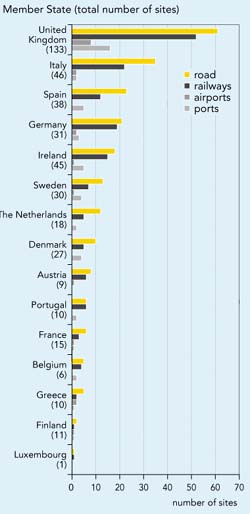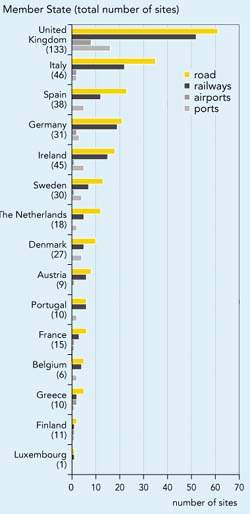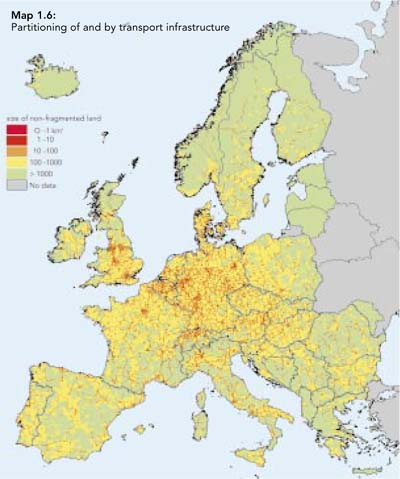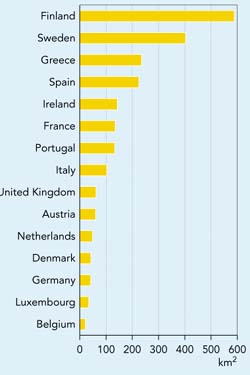Indicator 5: Proximity of transport infrastructures to designated nature areas / Fragmentation
|
The expansion of transport infrastructure networks
and the continuous growth in traffic in the EU pose an important threat
to biodiversity, and conflict more and more with nature conservation policies.
A total of 1 650 special bird areas (SPAs) designated up to 1997, or 66 %
of the total number designated, have at least one major transport infrastructure
within 5 km of their centres, as have 430 Ramsar sites (wetlands), or
63 % of the total. Further expansion of the transport infrastructure
and intensification of its use could jeopardise the future of many important
designated nature areas.
Figure 1.14a: Ramsar areas (wetlands)
with major transport infrastructure within 5 km of their centre

Source: EEA-ETC/LC
Objective
- Preserve biodiversity and protect designated
areas.
Definitions
- Number of SPAs and Ramsar wetland areas designated
for nature protection which have a major transport infrastructure (motorways,
national and principal roads, railways, airports and maritime ports)
within 5 km of their centre.
- Proxy indicator: Average size (in km²) of land
parcels that are not fragmented by transport infrastructure.
Note: special bird areas (SPAs) are those
designated by the EC Birds Directive; Ramsar wetlands are those designated
in the global Ramsar Convention for the protection of wetlands.
|
Policy and targets
Habitats and species are disturbed or damaged by traffic
noise and light, vehicle emissions, run-off substances from road surfaces and
runways (to which salt and other de-icing chemicals have been applied) and oil
discharges, particularly to rivers and seas. Some animal species are particularly
susceptible to collision with traffic. Proximity to major traffic infrastructure
and growth in traffic using such infrastructure can therefore clearly affect
habitats and species.
Linear infrastructure (roads, railways, canals) may
fragment habitats, thereby reducing the living space for endemic species, and
can provide new pathways for the influx of other species. They may also
act as barriers to movement and genetic interchange between populations, especially
for vertebrates. The splitting of communities can also have socio-economic impacts.
The UN Convention on Biological Diversity sets up a
general framework for the conservation of habitats and species. At the European
level, the Pan-European Biological and Landscape Diversity Strategy provides
a framework for coordination of various actions (on species, ecosystems, landscapes,
public awareness) between European states. However, lack of integration of biodiversity
concerns into other policy areas is currently one of the greatest obstacles
to securing conservation goals. Integration is therefore a key element of the
Community Biodiversity Strategy (CEC, 1998a).
The designation of areas for nature protection is one
of the longest established and most common measures for the protection of biodiversity.
Various international and national regulations have been established to this
end, such as the Birds (CEC, 1979) and Habitats (CEC, 1992) Directives. These
two Directives aim at protecting more than 10 % of the territory of the
EU through designation of sites for nature protection during the first decade
of the new century. However, infringements of existing nature conservation regulations
as a result of transport infrastructure projects are still regularly reported.
Even though environmental impact assessments (EIAs) are now customarily carried
out for large transport infrastructure projects (in accordance with national
legislation and EU Directive on environmental impact assessment (CEC, 1985)),
these often fail to consider alternative routes to avoid pressures on nature.
Findings
|
Figure 1.14b: Special birds areas (SPA) with major
transport infrastructure within 5 km of their centre

Source: EEA-ETC/LC
This indicator gives an approximate indication of the
pressures that transport infrastructure and its use can impose on designated
nature areas, and can also provide an indication of the level of pressure
on other nature areas.
Proximity
Examination of the percentage of designated areas within 5 km of major
EU transport infrastructures reveals that the proximity problem:
- in Ramsar areas: is very high for roads and
railways, high for maritime ports in nearly all cases and less important
for airports (Figure 1.14a);
- in SPA areas: is high to very high for roads,
high but somewhat lower for railways, and much less important for airports
and maritime ports (Figure 1.14b).
Transport disturbance to biodiversity is higher
in Member States with dense infrastructures (such as Belgium, Austria,
the Netherlands, Germany, Denmark and Luxembourg). However, the problem
seems to be general and not dependent on the number of sites in the Member
State. Few nature protection areas are far from major transport infrastructure.
|
Overall:
- increases in major infrastructure are likely to significantly
increase the effect of transport infrastructure on existing designated areas
in all countries;
- it will be increasingly difficult to designate new
areas which will not be close to infrastructure elements.
Fragmentation
Map 1.6 shows that most areas in the EU are highly fragmented by transport infrastructure.
The average size of contiguous land units that are not cut through by major
transport infrastructure ranges from about 20 km² in Belgium to nearly 600 km²
in Finland, with an EU average of about 130 km² (Figure 1.15).
Map 1.6: Partitioning of land by transport infrastructure

Source: EEA-ETC/LC
Figure 1.15: Average size of non-fragmented land parcels

Source: EEA-ETC/LC
Future work
The proximity of transport infrastructure to a nature
conservation area is closely linked to the potential risk of disturbance to
that area. Data improvements that would enhance the value of this indicator
include:
- digitisation of information on the boundaries and
areas of designated nature areas;
- inclusion of other types of designated area (such
as those under the Habitats Directive);
- updated information on designated areas (including
information on species and habitat distribution) and on land cover;
- testing of the indicator using distances of disturbance
other than 5 km.
The EEA will further develop the fragmentation indicator
by carrying out an assessment of the ecological quality of land parcels.
Both indicators will be improved in close coordination
with various other initiatives at international and Member State levels. At
the European level, EEA, EUROSTAT and OECD are jointly developing indicators
for environmental reporting. The SBSTTA (Subsidiary Body on Scientific, Technical
and Technological Advice) of the Convention on Biological Diversity is developing
biological indicators.




Document Actions
Share with others